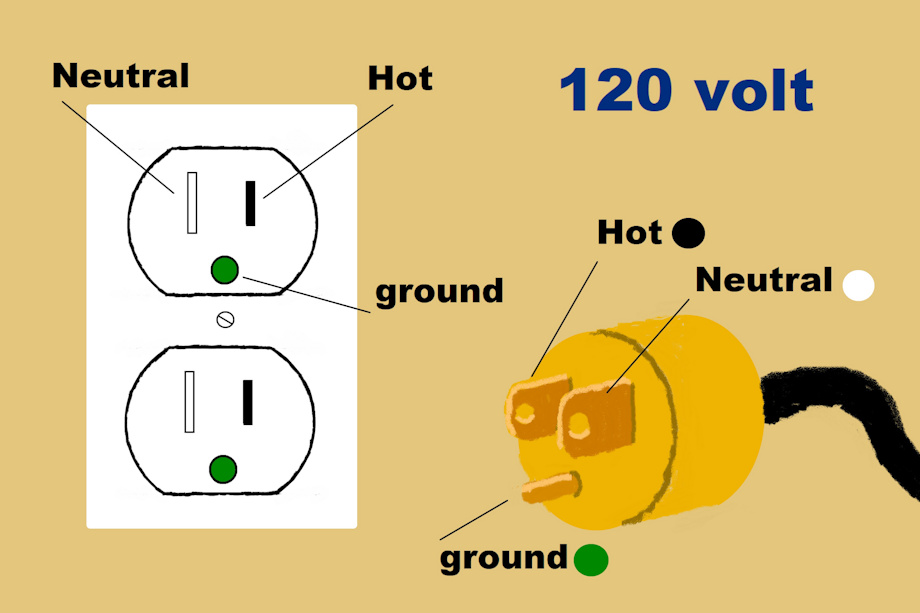I made this illustration based on information I Googled for the proper placement of the wires when attaching replacement plugs to cords, and attaching new cords to power tools and appliances. I am going to make a hard copy at a photo kiosk to paste onto a wall in my tool shed.
Being I had made this illustration, I figured I'd also post it here so it would be helpful to any of you who might want to take on repairing an extension cord or replacing a bad cord on a tool or appliance.
This information pertains to American cord wiring. In some countries it might be different.
I even have a heavy duty extension cord I made from 25 feet of three conductor, heavy gauge cable and the two industrial grade plug ends I've purchased.
I also have a half inch chuck, Harbor Freight, power drill that had the cord go bad. I repaired it with a 12 foot, heavy duty, extension cord by cutting the female end off and wiring the cord into the drill...It's probably the only drill around with a 12 foot cord.
I've got a Craftsman table saw I bought at a yard sale for $50 several years ago. Recently the power switch on it went bad. The saw is rated at 15 amp. I purchased a dollar forty cent, household, light switch rated at 15 amp from Ace Hardware. I wired in and it works great.
Not everyone knows which wire is which in power cords and extension cords, and some folks think it makes no difference where the wires get attached. It does make a big difference where they go. Wiring it wrong could short the hot wire to ground.
As a standard rule, 120 volt extension cords and power cords have three wires; black, white and green. And as everyone has noticed, typical American plugs have a small blade, a large blade and a ground prong.
The illustration in this posting shows the correct placement of those wires.
The small blade is the hot, and is where the black wire goes.
The large blade is the neutral, and is where the white wire goes.
The ground prong is where the green wire goes.
The same rule applies to the female plug as well.
If you ever have occasion to replace a 120 volt light switch or a socket in house wiring, and I've done a many of them myself, those receptacles have a chrome screw and a brass screw.
And for Heaven sake, kill the circuit breaker before replacing a receptacle!!!
The brass screw on a receptacle is where the black hot wire goes.
The chrome screw is where the white neutral wire goes.
There is also a screw threaded into the body, which is generally smaller. That is where the green ground wire goes.
It should be noted, sometimes there is house wiring where a contractor didn't use black, white and green wires. It a case such as that, be sure to make a note of which wires were attached where to the old receptacle that needed replacing.
Pic # 2 shows a diagram of a grounded single insulated power drill causing a short due to the plug being wired backwards.
I'm adding a note about 240 volt cords I've recently Googled. Last month, I was given a cloths dryer.
The only problem with it was the style of the plug was not compatible with the different style of the 240 house receptacle...The neutral/ground prong was shaped differently.
What I did was swap the cords from the old bad dryer. A 240 volt typically has two hots and one neutral/ground. However, I wasn't sure about the two hots, so I googled it.
What I found out from several Google sites was, it doesn't matter which hot lead goes to which outer terminal on the back of the dryer...or on anything else 240 volt.
What is important is that the neutral lead goes to the middle terminal. The neutral lead is also easy to identify...It is always in the middle between the two hot leads, and is usually smaller.
In short...Middle lead to middle terminal. Outer leads can go to either outer terminal.
By the way, that dryer works beautifully.
Details
Published:
2 years ago
25 Sep 2023 09:49 CEST
Initial: 100faf5cafd7a5b74ed3a7520d87fc91
Full Size: 881aa3a6c5d06f7ae38dfd7ec1974a4c
Large: fdeb955fc45823d37a3f25685e4116c5
Small: b7a5171f3bfa0e8d68add6a6b5fa4545
Stats
103 views
11 favorites
15 comments
